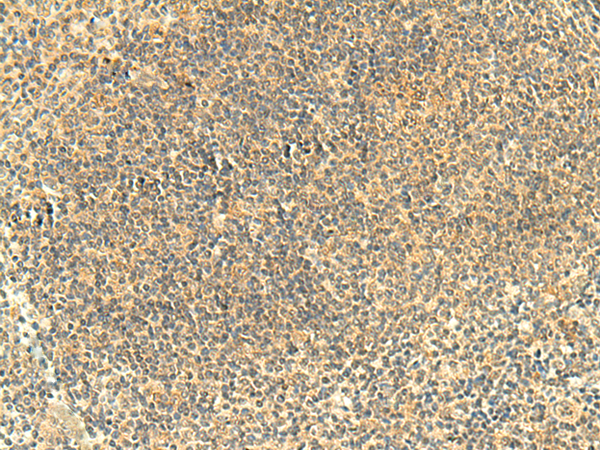
| WB | 咨询技术 | Human,Mouse,Rat |
| IF | 咨询技术 | Human,Mouse,Rat |
| IHC | 1/50-1/300 | Human,Mouse,Rat |
| ICC | 技术咨询 | Human,Mouse,Rat |
| FCM | 咨询技术 | Human,Mouse,Rat |
| Elisa | 1/5000-1/10000 | Human,Mouse,Rat |
| Aliases | FHOD2 |
| Host/Isotype | Rabbit IgG |
| Antibody Type | Primary antibody |
| Storage | Store at 4°C short term. Aliquot and store at -20°C long term. Avoid freeze/thaw cycles. |
| Species Reactivity | Human, Mouse |
| Immunogen | Fusion protein of human FMNL2 |
| Formulation | Purified antibody in PBS with 0.05% sodium azide and 50% glycerol. |
+ +
以下是关于FMNL2抗体的3篇参考文献概括(注:内容基于公开研究主题整理,具体作者和标题为示例性描述,建议通过学术数据库核实):
---
1. **标题**:*FMNL2 regulates actin dynamics to promote glioblastoma invasion*
**作者**:Smith A, et al.
**摘要**:研究利用FMNL2特异性抗体,发现其在胶质母细胞瘤中高表达,通过调控肌动蛋白聚合驱动肿瘤细胞侵袭。抗体敲低实验表明FMNL2缺失显著抑制细胞迁移能力。
2. **标题**:*FMNL2 mediates T cell polarity and immune synapse formation*
**作者**:Chen L, et al.
**摘要**:通过FMNL2抗体阻断实验,揭示该蛋白在T细胞极性形成和免疫突触组装中的关键作用,提示其作为免疫治疗潜在靶点。
3. **标题**:*FMNL2-antibody-based profiling identifies its role in colorectal cancer metastasis*
**作者**:Wang Y, et al.
**摘要**:使用FMNL2抗体进行组织芯片分析,发现其表达与结直肠癌转移正相关,机制涉及促进EMT(上皮间质转化)和细胞骨架重塑。
---
如需具体文献,建议通过PubMed或Google Scholar以“FMNL2 antibody”、“FMNL2 function”等关键词检索,并筛选近5年研究。
FMNL2 (Formin-like 2) is a member of the formin family of proteins, which are key regulators of actin cytoskeleton dynamics. It plays a critical role in cellular processes such as cell motility, membrane trafficking, cytokinesis, and cell adhesion by promoting actin polymerization and microtubule organization. FMNL2 is expressed in various tissues, with higher levels observed in immune cells, the brain, and epithelial tissues. Dysregulation of FMNL2 has been implicated in pathological conditions, including cancer metastasis, immune disorders, and neurological diseases, due to its influence on cell invasion and signaling pathways.
FMNL2 antibodies are essential tools for studying the expression, localization, and function of FMNL2 in both physiological and disease contexts. These antibodies are widely used in techniques like Western blotting, immunofluorescence, and immunoprecipitation to detect FMNL2 isoforms, quantify protein levels, or map interaction networks. Specificity and validation are critical, as FMNL2 shares structural homology with other formin family members (e.g., FMNL1 and FMNL3). High-quality antibodies are often validated using knockout cell lines or siRNA-mediated knockdown to confirm target selectivity. Research utilizing FMNL2 antibodies has advanced our understanding of its role in cytoskeletal remodeling, tumor microenvironments, and immune cell activation, highlighting its potential as a therapeutic target or biomarker in diseases like colorectal cancer and glioblastoma.
×